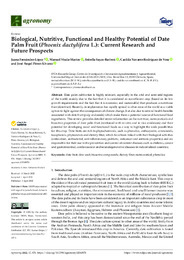Por favor, use este identificador para citar o enlazar este ítem:
https://hdl.handle.net/11000/31792Registro completo de metadatos
| Campo DC | Valor | Lengua/Idioma |
|---|---|---|
| dc.contributor.author | Fernandez-Lopez, Juana | - |
| dc.contributor.author | Viuda-Martos, Manuel | - |
| dc.contributor.author | Sayas-Barberá, Estrella | - |
| dc.contributor.author | NAVARRO RODRIGUEZ DE VERA, CASILDA | - |
| dc.contributor.author | Pérez-Alvarez, José Angel | - |
| dc.contributor.other | Departamentos de la UMH::Tecnología Agroalimentaria | es_ES |
| dc.date.accessioned | 2024-03-21T12:54:47Z | - |
| dc.date.available | 2024-03-21T12:54:47Z | - |
| dc.date.created | 2022-04-03 | - |
| dc.identifier.citation | Agronomy 2022, 12(4), 876 | es_ES |
| dc.identifier.issn | 2073-4395 | - |
| dc.identifier.uri | https://hdl.handle.net/11000/31792 | - |
| dc.description.abstract | Date palm cultivation is highly relevant, especially in the arid and semi-arid regions of the world, mainly due to the fact that it is considered an eco-efficient crop (based on its few growth requirements and the fact that it is economic and sustainable) that produces a nutritious fruit (date fruit). Recently, its implantation has rapidly spread to other areas of the world as a viable option to fight against the consequences of climate change, but also due to several health benefits associated with date fruit (pulp and seeds) which make them a potential source of functional food ingredients. This review provides detailed recent information on the nutrition, nutraceuticals and bioactive properties of date palm fruit (reinforced with in vitro and in vivo evidences) and their potential for developing novel and functional foods as a way to highlight the wide possibilities for this crop. Date fruits are rich in phytochemicals, such as phenolics, anthocyanin, carotenoids, tocopherols, phytosterols and dietary fiber, which have been linked with their biological activities (antioxidant, antibacterial, anti-inflammatory, prebiotic, anticancer and antitoxic properties) and are responsible for their use in the prevention and control of current diseases such as diabetes, cancer and gastrointestinal, cardiovascular and neurodegenerative diseases in industrialized countries | es_ES |
| dc.format | application/pdf | es_ES |
| dc.format.extent | 30 | es_ES |
| dc.language.iso | eng | es_ES |
| dc.publisher | MDPI | es_ES |
| dc.rights | info:eu-repo/semantics/openAccess | es_ES |
| dc.rights | Attribution-NonCommercial-NoDerivatives 4.0 Internacional | * |
| dc.rights.uri | http://creativecommons.org/licenses/by-nc-nd/4.0/ | * |
| dc.subject | Date fruit | es_ES |
| dc.subject | Date seed | es_ES |
| dc.subject | Bioactive compounds | es_ES |
| dc.subject | Dietary fiber | es_ES |
| dc.subject | Nutraceutical | es_ES |
| dc.subject | Phenolics | es_ES |
| dc.subject.other | CDU::6 - Ciencias aplicadas::66 - Ingeniería, tecnología e industria química. Metalurgia::663/664 - Alimentos y nutrición. Enología. Aceites. Grasas | es_ES |
| dc.title | Biological, Nutritive, Functional and Healthy Potential of Date Palm Fruit (Phoenix dactylifera L.): Current Research and Future Prospects | es_ES |
| dc.type | info:eu-repo/semantics/article | es_ES |
| dc.relation.publisherversion | https://doi.org/10.3390/agronomy12040876 | es_ES |

Ver/Abrir:
Biological, Nutritive, Functional and Healthy Potential-Agronomy.pdf
2,13 MB
Adobe PDF
Compartir:
 La licencia se describe como: Atribución-NonComercial-NoDerivada 4.0 Internacional.
La licencia se describe como: Atribución-NonComercial-NoDerivada 4.0 Internacional.
.png)